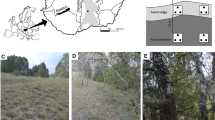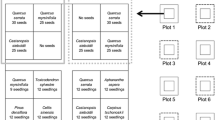Abstract
We studied how the unusual capacity of mature Fagus grandifolia to form clumps of clonal stems from root sprouts can contribute to its frequent codominance with Acer saccharum in southern Quebec, Canada. In an old-growth forest, the degree of dominance by the two species shifted along topographic gradients spanning a few hundreds of meters, with Fagus more frequent on lower slopes and Acer on upper slopes. The frequency distribution of Fagus stem diameter had an inverse J distribution at all slope positions, which is indicative of continuous recruitment. Acer stem diameter also had an inverse J pattern, except at lower slope positions where size structure was discontinuous. For stems <2 m tall, Fagus regenerated mainly by sprouts at the upper and mid-slopes, while regeneration from seed was more pronounced on the lower slope. This change of regeneration mode affected the spatial pattern of Fagus stems. Understory trees of Fagus were positively correlated with conspecific canopy trees on upper and mid-slopes, but not on lower slopes where Fagus regenerated mainly by seedlings. Understory trees of Acer were positively correlated with conspecific canopy trees only on the mid-slope. There were many Fagus seedlings around Acer canopy trees at the lower slope, suggesting the potential replacement of Acer canopy trees by Fagus. This study suggests that the regeneration traits of the two species changed with slope position and that Fagus patches originating from root sprouts can contribute to the maintenance of Acer–Fagus codominance at the scale of local landscapes.




Similar content being viewed by others
References
Abrell DB, Jackson MT (1977) A decade of change in an old-growth beech-maple forest in Indiana. Am Mid Nat 98:22–32
Arii K (2002) Ecology of American beech and sugar maple in an old growth forest. Dissertation, McGill University
Arii K, Lechowicz MJ (2002) The influence of overstory trees and abiotic factors on the sapling community in an old-growth Fagus–Acer forest. Écoscience 9:386–396
Arii K, Hamel BR, Lechowicz MJ (2005) Environmental correlates of canopy composition at Mont St. Hilaire, Quebec, Canada. J Torrey Bot Soc 132:90–102
Beaudet M, Messier C, Pare D, Brisson J, Bergeron Y (1999) Possible mechanisms of sugar maple regeneration failure and replacement by beech in the Boise-des-Muir old-growth forest, Quebec. Écoscience 6:264–271
Beaudet M, Messier C, Canham C (2002) Predictions of understory light conditions in northern hardwood forests following parameterization, sensitivity analysis, and tests of the SORTIE light model. For Ecol Manage 165:235–248
Beaudet M, Brisson J, Gravel D, Messier C (2007) Effect of a major canopy disturbance on the coexistence of Acer saccharum and Fagus grandifolia in the understorey of an old-growth forest. J Ecol 95:458–467
Beaumont JP (1980) Etude de quelques composantes écologiques de stations à Monotropa uniflora L. au Mont St-Hilaire et à l’Arboretum Morgan, Québec. Thèse de maîtrise, Département des ressources renouvelables, Collège Macdonald. McGill University, Montreal
Bigelow SW, Canham CD (2002) Community organization of tree species along soil gradients in a north-eastern USA forest. J Ecol 90:188–200
Brisson J, Bergeron Y, Bouchard A, Leduc A (1994) Beech-maple dynamics in an old-growth forest in southern Québec, Canada. Écoscience 1:40–46
Canham CD (1988) Growth and canopy architecture of shade-tolerant trees: response to canopy gaps. Ecology 69:786–795
Canham CD, Papaik MJ, Uriarte M, McWilliams WH, Jenkins JC, Twery MJ (2006) Neighborhood analyses of canopy tree competition along environmental gradients in New England forests. Ecol Appl 16:40–554
Caspersen JP, Saprunoff M (2005) Seedling recruitment in a northern temperate forest: the relative importance of supply and establishment limitation. Can J For Res 35:978–989
Condit R, Sukumar R, Hubbell SP, Foster RB (1998) Predicting population trends from size distributions: a direct test in a tropical tree community. Am Nat 152:495–509
Cook BD (1971) Tree-age distribution in a northern hardwood forest. M. Sc. thesis, Department of Geography, McGill University
Cypher JC, Boucher DH (1982) Beech-maple coexistence and seedling growth rates at Mount Saint Hilaire, Quebec. Can J Bot 60:1279–1281
Doyon F, Gravel D, Nolet P, Bouillon D, Majeau L, Messier C, Beaudet M (2003) L’envahissement par le hêtre dans les érablières de l’Outaouais: phénomène fantôme ou glissement de balancier?. Institut québécois d’aménagement de la forêt feuillue. Ripon, Québec, p 16
Duchesne L, Ouimet R, Moore JD, Paquin R (2005) Changes in structure and composition of maple-beech stands following sugar maple decline in Québec, Canada. For Ecol Manage 208:223–236
Duguay SM, Arii K, Hooper M, Lechowicz MJ (2001) Ice storm damage and early recovery in an old-growth forest. Environ Monit Assess 67:97–108
Environment Canada (2002) Canadian climate normals, St. Hubert A., Quebec. (1928–1990) Meteorological Service of Canada. http://www.msc.ec.gc.ca/climate/climate_normals/show_normals/show_normals_e.cfm. Accessed 22 April 2002
Farrar JL (1995) Trees in Canada. Fitzhenry and Whiteside/Canadian Forest Service, Toronto
Finzi AC, van Breemen N, Canham CD (1998) Canopy tree-soil interactions within temperate forests: tree species effects on soil pH and exchangeable cations. Ecol Appl 8:447–454
Foré SA, Vankat JL, Schaefer RL (1997) Temporal variation in the woody understory of an old-growth Fagus–Acer forest and implications for overstory recruitment. J Veg Sci 8:607–614
Fox JF (1977) Alternation and coexistence of tree species. Am Nat 111:69–89
Grenon L, Cossette JM, Deschênes M, Lamontagne L (1999) Étude pédologique du comté de Rouville, Québec. Direction générale de la recherche, Agriculture et Agroalimentaire Canada. Bulletin d’extension no 10, Centre de recherche et de développement sur les sols et les grandes cultures. Quebec
Hane EN (2003) Indirect effects of beech bark disease on sugar maple seedling survival. Can J For Res 33:807–813
Hane AN, Hamburg SP, Barber AL, Plaut JF (2003) Phytotoxicity of American beech leachate to sugar maple seedlings in a greenhouse experiment. Can J For Res 33:814–821
Held ME (1983) Pattern of beech regeneration in the east-central United States. Bull Torrey Bot Club 110:55–62
Hett JM, Loucks OL (1976) Age structure models of balsam fir and eastern hemlock. J Ecol 64:1029–1044
Hooper MC, Arii K, Lechowicz MJ (2001) Impact of a major ice storm on an old-growth hardwood forest. Can J Bot 79:70–75
Horsley SB, Long RP, Bailey SW, Hallett RA, Hall TJ (2000) Factors associated with the decline disease of sugar maple on the Allegheny Plateau. Can J For Res 30:1365–1378
Hukushima T (1995) New phytosociological classification of beech forests in Japan. Jpn J Ecol 45:79–98 (in Japanese)
Iverson LR, Prasad AM (1998) Predicting abundance of 80 tree species following climate change in the Eastern United States. Ecol Monogr 68:65–485
Iwao S (1977) Analysis of spatial association between two species based on the interspecies mean crowding. Res Pop Ecol 18:243–260
Jones RH, Raynal DJ (1986) Spatial distribution and development of root sprouts in Fagus grandifolia (Fagaceae). Am J Bot 73:1723–1731
Kitamura K, Kawano S (2001) Regional differentiation in genetic components for the American beech, Fagus grandifolia Ehrh., in relation to geological history and mode of reproduction. J Plant Res 114:353–368
Kitamura K, Kawano S (2005) Statistical genetics of tree populations. In: Hori Y, Ohara M (eds) Comparative life histories of plants—what can we learn by looking at trees and herbs? Bun-ichi Sogo Shuppan, Tokyo (in Japanese)
Kitamura K, Takasu H, Hayashi K, Ohara M, Ohkawa T, Utech FH, Kawano S (2000) Demographic genetic analyses of the American beech (Fagus grandifolia Ehrh.) I. Genetic substructurings of northern populations with root suckers in Quebec and Pennsylvania. Plant Species Biol 15:43–58
Kobe RK, Liken GE, Eager C (2002) Tree seedling growth and mortality responses to manipulations of calcium and aluminum in a northern hardwood forest. Can J For Res 32:954–966
Kohyama T, Takada T (1998) Recruitment rates in forest plots: Gf estimates using growth rates and size distributions. J Ecol 86:633–639
Melancon S, Lechowicz MJ (1987) Differences in the damage caused by glaze ice on codominant Acer saccharum and Fagus grandifolia. Can J Bot 65:1157–1159
Pacala SW (1986) Neighborhood models of plant population dynamics. 2. Multispecies models of annuals. Theor Popul Biol 29:262–292
Pacala SW, Levin SA (1997) Biologically generated spatial pattern and the coexistence of competing species. In: Tilman D, Kareiva P (eds) Spatial ecology. Princeton University Press, Princeton, pp 204–232
Payette S, Fortin JJ, Morneau C (1996) The recent sugar maple decline in southern Quebec: probable causes deduced from tree rings. Can J For Res 26:1069–1078
Poulson TL, Platt WJ (1996) Replacement patterns of beech and sugar maple in Warren Woods, Michigan. Ecology 77:1234–1253
Rhoads AG, Hamburg SP, Fahey TJ, Siccama TG, Hane EN, Battles J, Cogbill C, Randall J, Wilson G (2002) Effects of an intense ice storm on the structure of a northern hardwood forest. Can J For Res 32:1763–1775
Rouse WR, Wilson RG (1969) Time and space variations in the radiant energy fluxes over sloping forested terrain and their influence on seasonal heat and water balances at a middle latitude site. Geogr Ann 51:160–175
Runkle JR (1981) Gap regeneration in some old-growth forests of the eastern United States. Ecology 62:1041–1051
Runkle JR (1984) Development of woody vegetation in treefall gaps in a beech-sugar maple forest. Holarctic Ecol 7:157–164
Silvertown J, Holtier S, Johnson J, Dale P (1992) Cellular automaton models of interspecific competition for space—the effect of pattern on process. J Ecol 80:527–534
Takahashi K, Kohyama T (1999) Size-structure dynamics of two conifers in relation to understorey dwarf bamboo: a simulation study. J Veg Sci 10:833–842
Takahashi K, Lechowicz MJ (2008) Do interspecific differences in sapling growth traits contribute to the codominance of Acer saccharum and Fagus grandifolia? Ann Bot 101:103–109
Takahashi K, Arii K, Lechowicz MJ (2007) Quantitative and qualitative effects of a severe ice storm on an old-growth beech-maple forest. Can J For Res 37:598–606
Tubbs CH, Houston DR (1990) Fagus grandifolia Ehrh. In: Burns RM, Honkala BH (eds) Silvics of North America: 2. Hardwoods, Agriculture Handbook 654. US Department of Agriculture, Forest Service, Washington, pp 325–332
Van Breemen N, Finzi AC, Canham CD (1997) Canopy tree-soil interactions within temperate forests: effects of fine-scale variation in soil texture on canopy tree distribution. Can J For Res 27:1110–1116
Ward RT (1956) The beech forests of Wisconsin: changes in forest composition and the nature of the beech border. Ecology 37:407–419
Ward RT (1961) Some aspects of the regeneration habits of the American beech. Ecology 42:828–832
Watanabe R, Ida H (2001) Studies of a climax Fagus crenata forest of Kayanodaira Heights in central Japan VI. Forest dynamics for 20-year period from 1980 to 2000. Bull Inst Nat Edu Shiga Heights, Shinshu Univ 42:7–11 (in Japanese)
Woods KD (1979) Reciprocal replacement and the maintenance of codominance in a beech–maple forest. Oikos 33:31–39
Woods KD (1984) Patterns of tree replacement: canopy effects on understory pattern in hemlock–northern hardwood forests. Vegetatio 56:87–107
Woods KD (2000a) Dynamics in late-successional hemlock–hardwood forests over three decades. Ecology 81:110–126
Woods KD (2000b) Long-term change and spatial pattern in a late-successional hemlock–northern hardwood forest. J Ecol 88:267–282
Woods KD (2007) Predictability, contingency, and convergence in late succession: slow systems and complex data-sets. J Veg Sci 18:543–554
Acknowledgments
We thank Ariane Dumas and Xavier Morin for their help in the field, Benoît R. Hamel for logistical support, and two anonymous reviewers for constructive comments. This work was supported by funds from the Japan Society for Promotion of Science to K.T. and the Natural Sciences and Engineering Research Council of Canada to M.J.L. We thank McGill University for its stewardship of the Gault Nature Reserve (http://www.mcgill.ca/gault/).
Author information
Authors and Affiliations
Corresponding author
Rights and permissions
About this article
Cite this article
Takahashi, K., Arii, K. & Lechowicz, M.J. Codominance of Acer saccharum and Fagus grandifolia: the role of Fagus root sprouts along a slope gradient in an old-growth forest. J Plant Res 123, 665–674 (2010). https://doi.org/10.1007/s10265-010-0312-y
Received:
Accepted:
Published:
Issue Date:
DOI: https://doi.org/10.1007/s10265-010-0312-y




